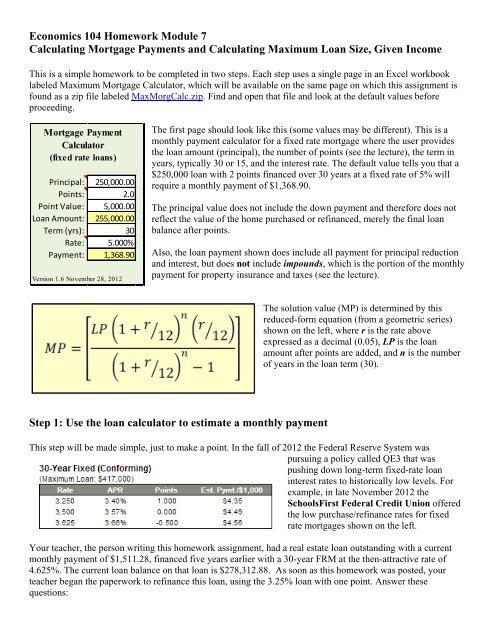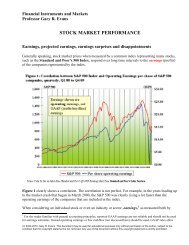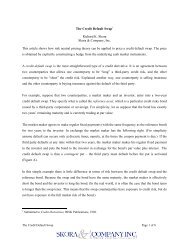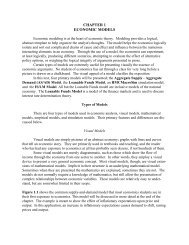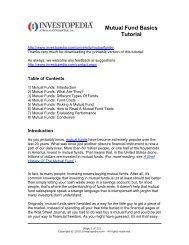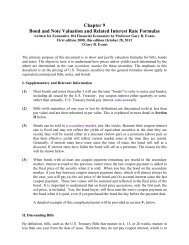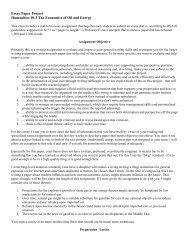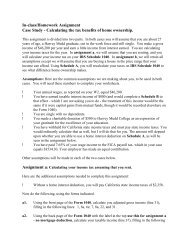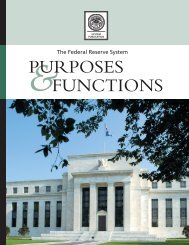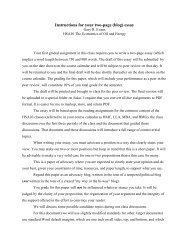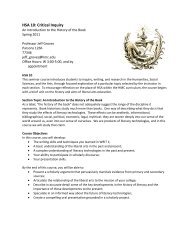Calculating Mortgage Payments and Calculating Maximum Loan Size
Calculating Mortgage Payments and Calculating Maximum Loan Size
Calculating Mortgage Payments and Calculating Maximum Loan Size
You also want an ePaper? Increase the reach of your titles
YUMPU automatically turns print PDFs into web optimized ePapers that Google loves.
Economics 104 Homework Module 7<br />
<strong>Calculating</strong> <strong>Mortgage</strong> <strong>Payments</strong> <strong>and</strong> <strong>Calculating</strong> <strong>Maximum</strong> <strong>Loan</strong> <strong>Size</strong>, Given Income<br />
This is a simple homework to be completed in two steps. Each step uses a single page in an Excel workbook<br />
labeled <strong>Maximum</strong> <strong>Mortgage</strong> Calculator, which will be available on the same page on which this assignment is<br />
found as a zip file labeled MaxMorgCalc.zip. Find <strong>and</strong> open that file <strong>and</strong> look at the default values before<br />
proceeding.<br />
<strong>Mortgage</strong> Payment<br />
Calculator<br />
(fixed rate loans)<br />
Principal: 250,000.00<br />
Points: 2.0<br />
Point Value: 5,000.00<br />
<strong>Loan</strong> Amount: 255,000.00<br />
Term (yrs): 30<br />
Rate: 5.000%<br />
Payment: 1,368.90<br />
Version 1.6 November 28, 2012<br />
The first page should look like this (some values may be different). This is a<br />
monthly payment calculator for a fixed rate mortgage where the user provides<br />
the loan amount (principal), the number of points (see the lecture), the term in<br />
years, typically 30 or 15, <strong>and</strong> the interest rate. The default value tells you that a<br />
$250,000 loan with 2 points financed over 30 years at a fixed rate of 5% will<br />
require a monthly payment of $1,368.90.<br />
The principal value does not include the down payment <strong>and</strong> therefore does not<br />
reflect the value of the home purchased or refinanced, merely the final loan<br />
balance after points.<br />
Also, the loan payment shown does include all payment for principal reduction<br />
<strong>and</strong> interest, but does not include impounds, which is the portion of the monthly<br />
payment for property insurance <strong>and</strong> taxes (see the lecture).<br />
The solution value (MP) is determined by this<br />
reduced-form equation (from a geometric series)<br />
shown on the left, where r is the rate above<br />
expressed as a decimal (0.05), LP is the loan<br />
amount after points are added, <strong>and</strong> n is the number<br />
of years in the loan term (30).<br />
Step 1: Use the loan calculator to estimate a monthly payment<br />
This step will be made simple, just to make a point. In the fall of 2012 the Federal Reserve System was<br />
pursuing a policy called QE3 that was<br />
pushing down long-term fixed-rate loan<br />
interest rates to historically low levels. For<br />
example, in late November 2012 the<br />
SchoolsFirst Federal Credit Union offered<br />
the low purchase/refinance rates for fixed<br />
rate mortgages shown on the left.<br />
Your teacher, the person writing this homework assignment, had a real estate loan outst<strong>and</strong>ing with a current<br />
monthly payment of $1,511.28, financed five years earlier with a 30-year FRM at the then-attractive rate of<br />
4.625%. The current loan balance on that loan is $278,312.88. As soon as this homework was posted, your<br />
teacher began the paperwork to refinance this loan, using the 3.25% loan with one point. Answer these<br />
questions:
1a. What will be you teacher's new monthly payment?<br />
1b. What will be your teacher's monthly savings from refinancing?<br />
Step 2: Mudder gets a job <strong>and</strong> buys a house, or does not buy a house.<br />
That was easy. Now go to the second page of your Excel Workbook <strong>and</strong> find the <strong>Maximum</strong> <strong>Loan</strong> Calculator,<br />
which will look like this spread on the left.<br />
<strong>Maximum</strong> <strong>Loan</strong> Calculator<br />
(fixed rate mortgage)<br />
Net Monthly Income: 4,000.00<br />
Threshold %: 40<br />
Max Monthly Payment: 1,600.00<br />
Max Monthly: 1600.00<br />
Desired term: 30<br />
Rate (%): 5.000%<br />
UnAdj Max <strong>Loan</strong>: 298,051<br />
Points (%): 2.0<br />
Net Max <strong>Loan</strong> Balance: 292,206<br />
Down Payment %: 10<br />
Max Home Value: 324,674<br />
Memo: Down Payment: 32,467<br />
This is based on the part of the lecture where you try to estimate the<br />
maximum home value that you can afford given your monthly<br />
income (take-home pay), interest rates, <strong>and</strong> down payment that you<br />
have saved.<br />
In the default example, net monthly income (which would be aftertax<br />
joint (combined) income if married) is assumed to be $4,000 per<br />
month where the borrower is using an aggressive 40% income<br />
threshold (35% would be more moderate - see the lecture) <strong>and</strong> is<br />
considering financing with a 30-year FRM available at 5% with 2<br />
points. Assuming that the borrower has the necessary down<br />
payment of 10%, then the maximum home value that this income<br />
can afford is a little less than $325,000.<br />
Obviously if the borrower has a lower down payment than that<br />
shown then that would place an upper cap upon the maximum home<br />
value. In other words, if the borrower has only $25,000 for a down<br />
payment, if the minimum down payment required is 10%, then<br />
obviously the maximum loan value for that borrower is $225,000,<br />
regardless of any income that would qualify for more.<br />
Suppose you graduate from college <strong>and</strong> you go to work in Portl<strong>and</strong> Oregon for Intel or a tech firm that pays a<br />
good salary. You are still single. Suppose your net monthly income equals $4,250 per month. Your parents tell<br />
you that they will give you an amount equal to 10% of<br />
the value of any home you buy so long as you otherwise<br />
qualify for a loan, so you don't have to worry about a<br />
down payment. At the time you start looking lending<br />
rates have risen some from where they were in November<br />
2012, but are still low at 3.75% with 1 point for a 30-<br />
year FRM <strong>and</strong> 3.15% with 1 point for a 15-year FRM. It<br />
is also clear that the bank will accept a 40% threshold.<br />
You start looking around <strong>and</strong> you spot the home shown<br />
on the left for sale for $399,950. [This was an actual<br />
house for sale at this price in Portl<strong>and</strong> in late 2012[.<br />
Question 2a: Can you afford this home if your parents<br />
give you the down payment?
Question 2b: What would be your payment on this house of you wanted to finance it on a 15-year FRM?<br />
Could you afford that?<br />
Question 2c: Suppose you decide to wait for four years <strong>and</strong> the full effect of QE3 kicks in, producing a modest<br />
inflation <strong>and</strong> a surge in interest rates. Your income keeps up with inflation <strong>and</strong> you also get married, so your<br />
joint combined income climbs to $9,000 monthly. That's a lot! But this little house is now worth $520,000, a<br />
price that it had in 2005 (literally!) <strong>and</strong> now the 30-year FRM is 8% at 2 points.<br />
Can you <strong>and</strong> your new spouse buy the house now?<br />
Final Exam Question: If you get a job in Portl<strong>and</strong> Oregon upon graduation <strong>and</strong> your parents offer to make<br />
your down payment on a home loan, will you be able to afford such a purchase? What might happen if you<br />
wait? What did your homework tell you about this?


